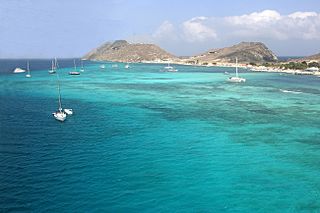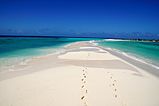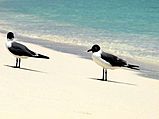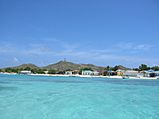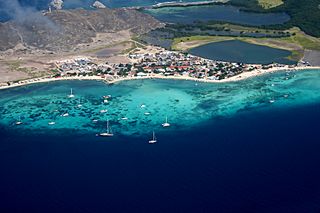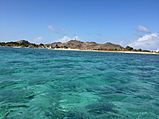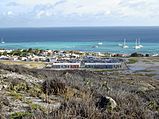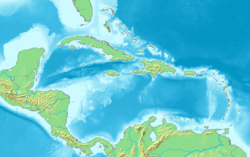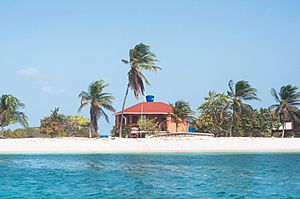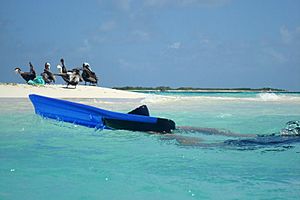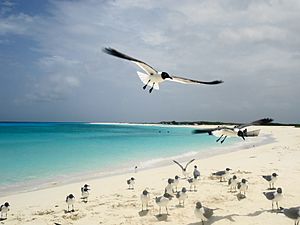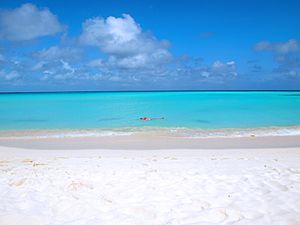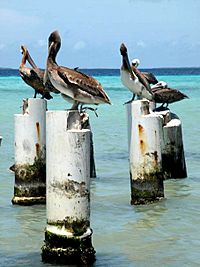Los Roques Archipelago facts for kids
|
Native name:
Dependencia Federal Archipiélago Los Roques
Nickname: Los Roques
|
|
|---|---|
| Geography | |
| Location | Caribbean Sea |
| Coordinates | 11°51′27″N 66°45′27″W / 11.85750°N 66.75750°W |
| Total islands | 350 |
| Major islands | Gran Roque |
| Area | 40.61 km2 (15.68 sq mi) |
| Highest elevation | 120 m (390 ft) |
| Highest point | Cerro El Cabezón |
| Administration | |
|
Venezuela
|
|
| Federal dependencies of Venezuela | |
| Largest settlement | Gran Roque |
| Demographics | |
| Population | 3,100 (2014) |
| Pop. density | 44.32 /km2 (114.79 /sq mi) |
| Official name: Parque Nacional Archipiélago Los Roques | |
| Designated: | 4 September 1996 |
| Reference #: | 856 |
The Los Roques Archipelago (Spanish: Archipiélago de Los Roques) is a group of about 350 islands, small sandy islands (called cays), and tiny islands (called islets). It's a special area of Venezuela in the Caribbean Sea. The total area of these islands is about 40.61 square kilometers.
Los Roques is located about 128 kilometers (80 miles) north of La Guaira, a port city in Venezuela. The islands have beautiful coral reefs. These reefs attract many visitors, especially from Europe. Some visitors even arrive on their own yachts.
The Venezuelan government made Los Roques a National Park in 1972. This was done to protect the many different seabirds and the rich ocean life found there.
Contents
History of Los Roques Archipelago
The first people to visit Los Roques were Native Americans from the Caribbean. They came to gather shellfish, fish, hunt turtles, and collect salt. You can still see old salt flats with stone paths and remains of houses from this time.
Later, fishermen from Margarita Island in Venezuela started to settle permanently in Los Roques with their families. The names of many islands and cays come from a mix of cultures. For example, the native word "cayo" became "key" in English. This then turned into "qui" in Spanish. This is how names like Francisquí (from Frank's key) and Crasquí (from Crab's key) came to be.
Early European Visits
Spanish sailors first saw these islands a long time ago. In 1589, the governor of Venezuela officially claimed the islands for Spain.
The Dutch also thought Los Roques belonged to their island territory of Curaçao. This was because it was close to Bonaire, which was a Dutch island.
In the 1700s, a trading company from Spain set up on the islands. They gave names to the first islands like Gran Roque and Cayo Sal. Fishermen also started visiting temporarily. In the 1800s, people began to mine salt and guano (bird droppings used as fertilizer).
Los Roques in Independent Venezuela
In 1871, the Venezuelan president, Antonio Guzmán Blanco, created the Territorio Colón. This territory included Los Roques and other nearby islands. Gran Roque was chosen as the main town.
Around 1886, people from nearby Dutch islands like Aruba and Curaçao moved to Los Roques. They gave some islands their unique names, like Francisquí and Madrisquí. The "quí" part of these names comes from the English word "key," meaning island.
In the early 1900s, an illness called the bubonic plague spread in La Guaira. The Venezuelan government used Gran Roque as a place for people to stay in quarantine.
By 1910, the town of Gran Roque grew with families, mostly fishermen, from Margarita Island.
On July 20, 1938, the islands became part of the Federal Dependencies of Venezuela. Then, on August 8, 1972, the archipelago was officially declared a national park.
After becoming a national park, the Los Roques Scientific Foundation was created. They built labs on Dos Mosquises island. Here, scientists study things like fish, turtles, corals, and fishing.
In 1990, a special administration called the Single Authority of Los Roques Area was created. This helped manage the islands better. In 2011, Los Roques became part of the Miranda Insular Territory. This is a larger group of islands with its capital in Gran Roque.
In 2019, a new airport was opened in Los Roques. It has a bigger runway and new buildings for national and international flights.
Geography of Los Roques
The main islands of Los Roques are shaped like an atoll. This means they have two outer barriers made of coral. Inside, there's a shallow lagoon and sandy areas.
The national park covers 40.61 square kilometers of land. It also includes 1,500 square kilometers of coral reefs. There are 42 coral cays around a shallow central lagoon of 400 square kilometers. The park also has two long barrier reefs and 300 sand banks, islands, and cays. These range in size from Cayo Grande (15.1 square kilometers) to Gran Roque (1.7 square kilometers). Other important islands are Francisqui, Nordisqui, Madrisqui, and Crasqui.
Climate in Los Roques
The climate in Los Roques is warm and dry. The average temperature is about 27.3°C (81.1°F). In July and August, it can reach 34°C (93°F). Sometimes it rains between September and January.
The wind blows steadily all year, which helps to keep the heat down. The skies are usually clear, so there's lots of sunshine.
National Park Zones
When Los Roques became a national park in 1972, a plan was made to protect its ecosystems. This plan divides the park into different zones. Each zone has rules about what activities are allowed, depending on how fragile the area is. The more protected a zone is, the fewer activities are permitted.
The Los Roques National Park has seven main zones:
- Integral Protection Zone: This is the most protected area. It includes keys like Sebastopol and Selesqui. These areas have important coral reefs, mangroves, and are breeding grounds for flamingos, seabirds, and sea turtles. Only scientific research is allowed here, and you need special permission.
- Primitive Marina Zone: This zone includes the waters around the protected keys, plus areas like Cayo de Agua. These are considered sensitive areas. You can go boating, sailing, swimming, snorkelling, and scuba diving here. Sport fishing and hiking on marked trails are also allowed. Groups for nature observation should be no more than 15 people.
- Managed Natural Environment Zone: This zone covers all the keys and waters around the archipelago. The same activities as in the Primitive Marina zone are allowed here.
- Recreation, Services, and Special Use Zones: These zones include islands like Gran Roque, where there are buildings and navigation channels. All the activities mentioned above are allowed here. You can also go camping with permission and enjoy water sports.
- Historical Cultural Interest and Archeopaleontology Zone: This zone protects areas where old artifacts have been found. Examples include Bequevé and Cayo de Agua.
Fauna (Animals) of Los Roques
Because of the dry conditions and lack of fresh water, there are not many land animals. You might see a few types of iguanas, lizards, spiders, and insects. The fishing bat is the only native land mammal.
However, the ocean around Los Roques is full of life! There are:
- 280 kinds of fish
- 200 kinds of crustaceans (like crabs and lobsters)
- 140 kinds of mollusks (like snails and clams)
- 61 kinds of corals
- 60 kinds of sponges
- 45 kinds of sea urchins and starfish
You can also find many dolphins, whales, manta rays, and turtles. The Sebastopol Lagoon is known as a nursery area for lemon sharks.
The most famous animals here are the green turtle, the pink queen conch, and the spiny lobster. Los Roques is also a stop for about 50 kinds of migratory birds from North America. Common birds include the brown pelican and different types of booby birds. Sometimes, you can even see groups of flamingos.
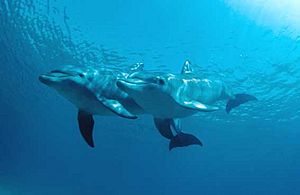
Four types of turtles lay their eggs in Los Roques. These turtles are on the worldwide list of threatened species. They include the loggerhead turtle, green turtle, leatherback turtle, and hawksbill turtle.
The coral reefs in Los Roques have many different types of corals and other sea creatures.
Flora (Plants) of Los Roques
Los Roques has several types of mangrove trees. These trees grow in salty water. You can also find large areas of seagrass underwater. On land, there are plants like glass grass and different types of cactus, such as prickly pear.
Government of Los Roques
Los Roques is a Federal Dependency. This means it is managed directly by officials chosen by the main government of Venezuela.
The main office for the head of government is on Gran Roque island. Other government groups, like Inparques (the National Parks Institute) and the National Guard of Venezuela, also have offices there.
How Los Roques is Governed
The head of government for the Miranda Island Territory is chosen by the president of Venezuela. This person stays in office as long as the main government trusts them.
Los Roques does not have its own law-making body. Its budget and laws are decided by the national government of Venezuela. This is done through the National Assembly in Caracas.
Population and Visitors
Los Roques does not have many permanent residents, only about 1,500 people. However, it gets around 70,000 visitors each year. Many of these visitors come for just one day from Caracas and the mainland.
Most people live on Gran Roque island and its nearby small islands. The population has grown over the years, but its growth is limited because it is a national park. Most residents are from Margarita Island and came to Los Roques to fish. Since the early 1900s, some foreigners, mostly Italians, have also moved there.
Tourism in Los Roques
Tourism in Los Roques has grown a lot in recent years. Before 1990, it wasn't a big tourist spot.
At first, only a few guesthouses existed. Wealthy Venezuelans and foreigners owned them. You could only get to Los Roques by small plane or private boat.
Today, there are over 60 guesthouses, 50 travel agencies, and six airlines. Most of these are on Gran Roque island, where tourism is allowed.
When tourism first boomed, most visitors were from other countries like the United States, Italy, and Germany. Now, many Venezuelans also visit, especially those who can afford the higher prices.
About 95% of tourists arrive by plane. The rest come by boat. Staying on a sailboat is another option, but it can be expensive. The cheapest way to stay is by camping in special areas set up by the park authorities. Most tourists (96%) stay in guesthouses.
For divers, the coral reef in Los Roques is one of the best preserved in the Caribbean. The water is warm and clear, making it easy to see many different fish and colorful plants. You can dive during the day or at night.
Los Roques is also great for Windsurfing and Kitesurfing. The wind blows all year, which is perfect for these sports. On Gran Roque, you can rent equipment and find guides or instructors.
Travel and Facilities
El Gran Roque is the only island where people live. It has an airport for small planes, called Los Roques Airport. Air traffic here is managed from the main airport in Maiquetía.
Most visitors arrive at El Gran Roque. From there, they go to the port and take small boats called "peñeros" to visit the other islands. These boats usually run from 9:00 AM to 4:00 PM.
Things to Do
There are many fun activities in Los Roques:
- Fishing: You can fish for different types of fish like bonefish and barracuda.
- Birdwatching: See many different kinds of birds.
- Snorkeling and Diving: Explore the amazing underwater world.
- Paddling, Windsurfing, and Kitesurfing: Enjoy water sports.
There's also a sea turtle research center on Dos Mosquises island. You can find places to stay like Pez Raton Lodge and Posada Mediterraneo.
See also
 In Spanish: Archipiélago Los Roques para niños
In Spanish: Archipiélago Los Roques para niños
- Federal Dependencies of Venezuela
- List of national parks of Venezuela


